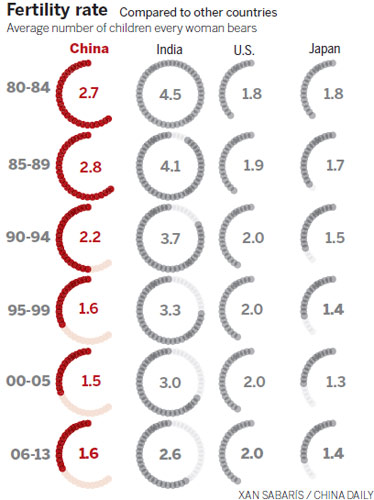

Work and life pressures are important reasons why many women do not want more children. Li Ming, the mother of a daughter and a middle school teacher in Shanghai, said: "The high living costs make having the second child a privilege of rich people. The government does not help couples to raise more kids."
China piloted a two-child policy in Jiuquan of Gansu province, Yicheng of Shanxi province, Chengde of Hebei province, and Enshi of Hubei province from 1980, involving about 8 million people. Statistics show the fertility rate in the four cities has remained under 2 for the past 35 years because of the poor public services in these inland areas.
Population and the economy
The aging population is taking its toll on the economy. According to the National Bureau of Statistics, the working-age population, people aged between 15 and 59 years old, was 937.27 million in 2012, 3.45 million lower than the previous year. This is the first time China has seen the decline of the absolute number of its working-age population since the early 1960s, when a great famine swept the country.
Wages started rising fast from two years ago, and more and more factories are being relocated to the central and the western regions of China, Southeast Asia and Africa as companies seek cheaper labor and resources.
"Population policy is not a spring, when the policy is loosened the fertility rate will not necessarily rebound. But the low fertility rate is an inevitable result of the tight birth control," said Guo Zhigang, professor of sociology at Peking University, adding that China must use foresight in making its population policy, or a fast aging population will sap the country's innovation and production capacity.
Malthus could not have predicted the world population would rise 25 percent from 750 million to 900 million in the second half of the 18th century, and explode 2.5 times from 2.4 billion to 6.1 billion in the second half of the 20th century, two periods that also witnessed the fastest improvements in productivity and people's livelihoods.
Most of the great famines in history are caused by low production, rather than population explosion. According to David Lam, professor of demography at US Population Studies Center, from 1960 to 2010, the grain output rose more than threefold, the average per capita grain output increased nearly one and a half times, and the comparable prices of several important non-renewable resources almost remained unchanged.
The World Bank's data show the poverty-stricken population's proportion in the population of the middle and low income countries dropped from 52 percent to 25 percent from 1981 to 2005.
The correlation also exists between China's fast population rise from 1950 to 1980 and its economic rise after the 1980s. UBS Securities estimates the population dividend has contributed to about 0.8 percentage points of growth for the Chinese economy each year over the past 30 years on average.
In the future, the dividend for China will come more from the innovation of its young and middle-aged population.
Population and innovation
Japan's economic stagnation that began in the 1990s is fundamentally caused by its aging population, and its rise after the 1960s and 1970s is a result of the baby boom after World War II and its efficient education system.
That the United States' population structure is more rational than that of Japan is an important reason why the US could maintain its innovation capacity after the 1990s while Japan's started declining.
China's census in 1964 showed young people under 15 years old accounted for more than 40 percent of its population. Yet, the proportion had fallen to 16.6 percent in 2010. By 2040, the median age of the US population will be about 40 years old, but China's will be about 50.
The UN predicts that the proportion of young people in China's total population will be even lower than that of Russia, only higher than the seriously aging Japan by 2030.
According to Yi Fuxian, a population policy researcher at the University of Wisconsin, if China cannot effectively stimulate young couples' willingness to have more children, India will overtake China in terms of population in 2040, when it will have 1.6 billion people, among whom 850 million will be of working age, compared with 690 million in China.
Worse, two-thirds of the young people in China, about 220 million now, are from the countryside, among whom more than 60 million are children living with their grandparents in villages left behind while their parents work in cities, and more than 30 million are migrant children living an unstable life with their migrant worker parents.
China's input in education approached 4 percent of GDP, an international benchmark, in 2012. But the excessive concentration of quality education resources in several big cities means many rural young people cannot enjoy proper education.
The government urgently needs to provide better healthcare, education, pensions, and employment opportunities, so as to minimize the former rigid family planning policy's negative influence on the national economy.
How to maintain a dynamic financial balance between caring for the elderly, and cultivating the youth, and between now and the future will be difficult tests for Chinese decision-makers.
But as Cai Fang, an economist at the Chinese Academy of Social Sciences in Beijing, said, if the government can accomplish the missions, the country's population dividends and comparative advantages in contrast with the other emerging economies will last to 2020.
Copyright ©1999-2018
Chinanews.com. All rights reserved.
Reproduction in whole or in part without permission is prohibited.